Family : Scorpaenidae

Text © Giuseppe Mazza

English translation by Mario Beltramini
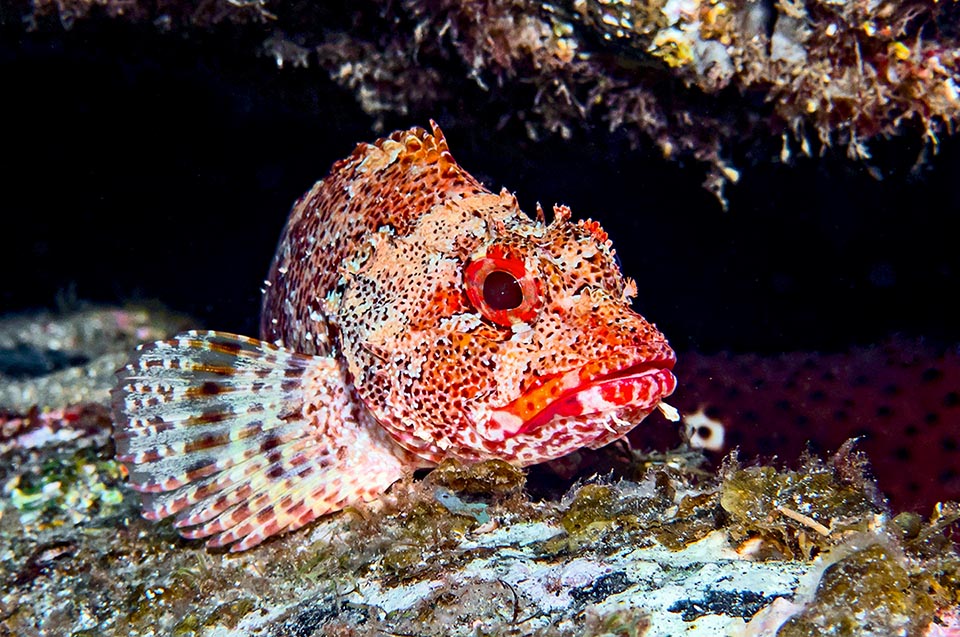
The Madeira rockfish (Scorpaena maderensis) is present throughout all Mediterranean, but the Black Sea, but we find it also in the Atlantic from the Bay of Biscay to Senegal © Brian Cole
Frequent but little observed in its range due to its small size and the mimetic livery, the Madeira rockfish (Scorpaena maderensis Valenciennes, 1833) belongs to the class of the Actinopterygii, the ray-finned fishes, to the order of the Scorpaeniformes and to the family of the Scorpaenidae.
The name of the genus Scorpaena is the one the old Romans gave to the scorpionfishes, evoking the scorpions, with reference to their poisonous spines. The specific term maderensis, of Madeira in Latin, refers to one of the sites where it lives.
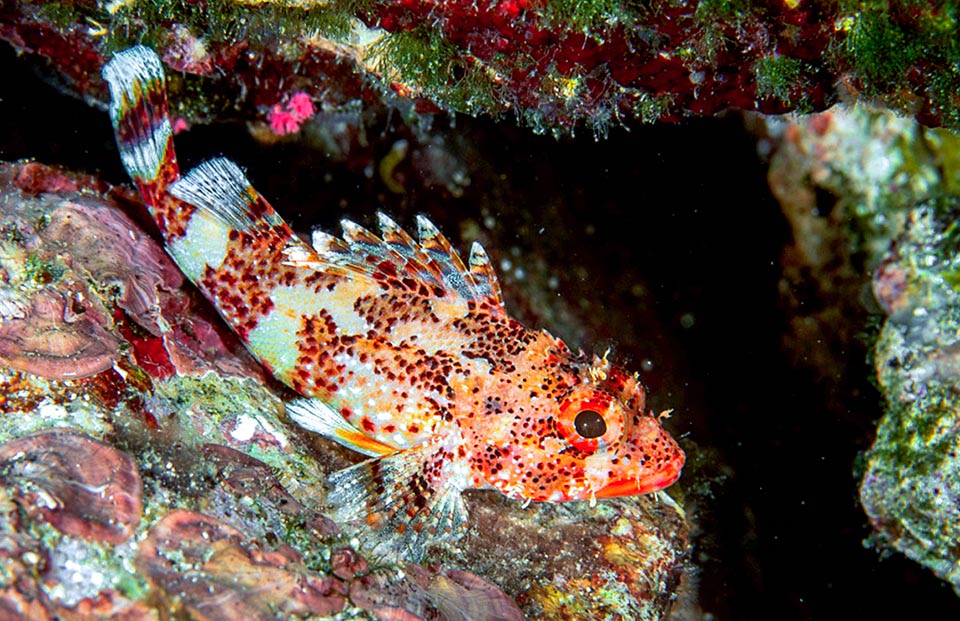
Usually measures 10 cm and is easy to recognize from the 3 dark bands on the body under the dorsal fin soft rays, the peduncle and the caudal fin © Tim Cameron
Zoogeography
The Madeira rockfish is present all over the Mediterranean, excepting the Black Sea. Once passed the Strait of Gibraltar, we find it northwards up to the Biscay Gulf, but with few members in the cooler waters, and soutwards up to Senegal, the islands of Madeira, Açores, Canaries and Cape Verde.
Ecology-Habitat
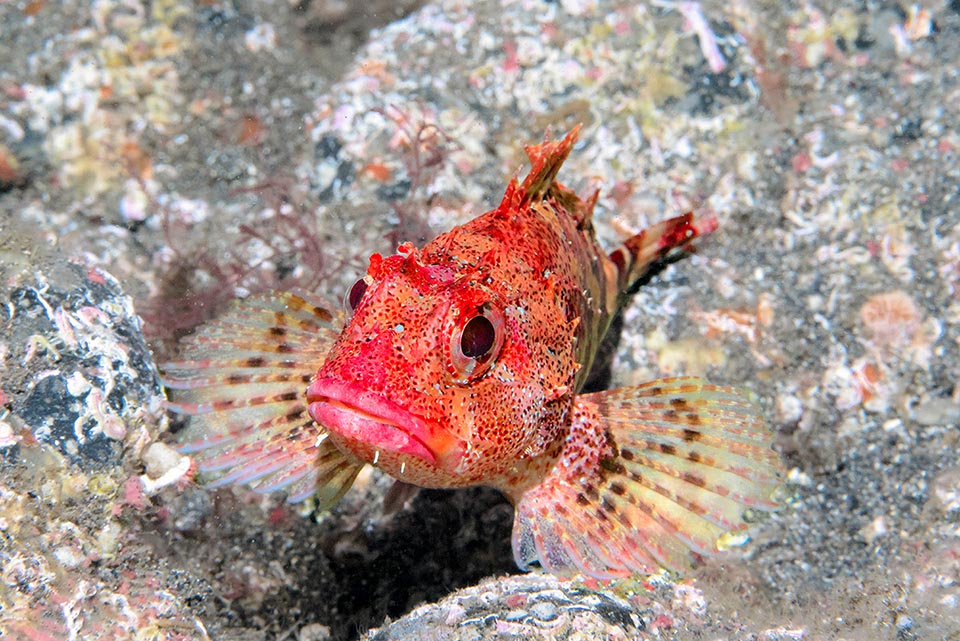
The head is less massive than the other scorpionfishes, protected by strong spines with two pairs of white skin flaps hanging from the lower lip © Brian Cole
Scorpaena maderensis never gets too far from the coasts, displaying a clear preference for the islands, and is found almost always motionless, invisible on the rocky seabeds rich in brown weeds between 20 and 40 m of depth, where it lives, often sedentary, and hunts in ambush waiting for the prey.
Morphophysiology
It is one of the smallest scorpionfishes, about ten centimetres long, even if the females, bigger than the males, reach 14 cm. The body is tall, protected by ctenoid scales well visible also on the chest and on the throat.
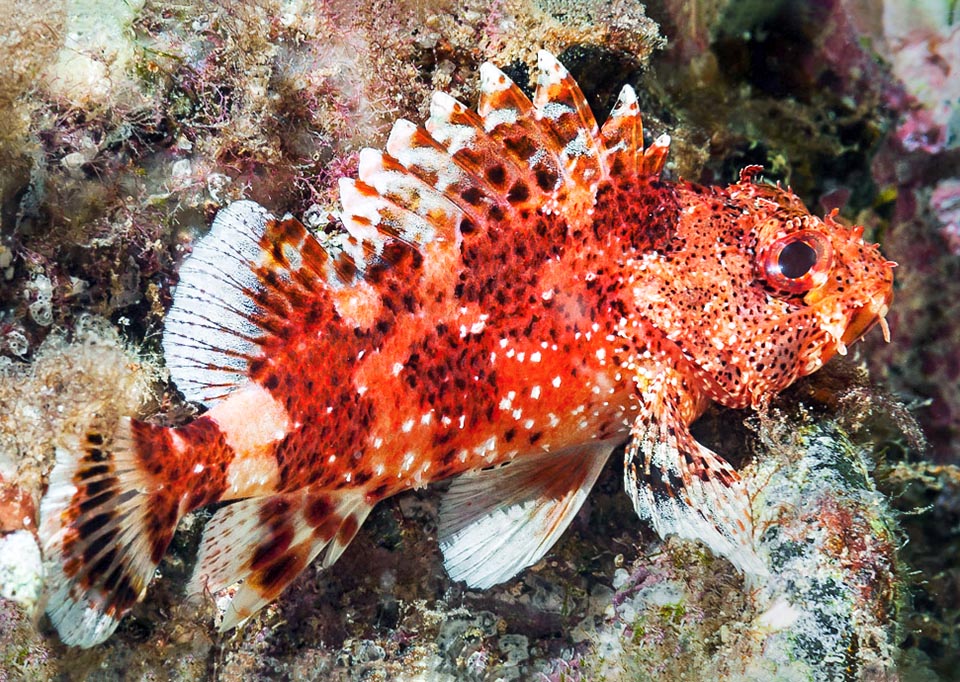
It also distinguishes without fail by the two white small traits that face each other, with widened base, in the narrowest point of the caudal peduncle © François Libert
The livery of Scorpaena maderensis, decidedly mimetic, shows clear spots and dark with brown, vinous or red hues, dotted with numerous white and black punctuations.
We note three dark vertical bands, at the beginning of the soft rays of the dorsal, on the caudal peduncle and on the caudal fin, but there are those who prefer to focus the attention on the adjacent three white bands: the first on the peduncle, then in the middle of the caudal fin and at its extremity.
If we compare it with that of other scorpionfishes, the head, which occupies almost one third of the length of the fish, is proportionally less stocky than usual with few laciniae and without the usual depression behind the eyes.
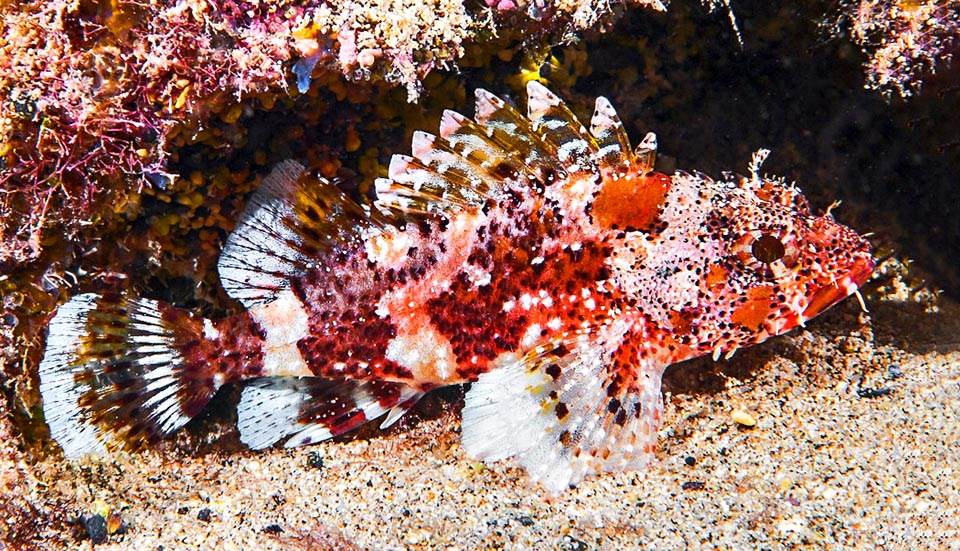
Here are well visible the venomous spiny rays of the dorsal fin, used with the others as defense, and the mimetic livery that may change with brown, vinous or red shades © François Libert
It is protected by robust spines, each with a venom gland at the base, present also on the operculum. When it opens wide the huge mouth is visible the tongue, merged below, and belts of villiform teeth for holding the preys, present also on the vomer and on the palatines.
From the lower jaw two flaps of white skin are dangling, probably intended to arouse curiosity to the ill-fated passers-by.
It is a small detail that allows to classify without fail this species, like the two small white traits that face each other, with the widened base, in the narrowest point of the caudal peduncle.
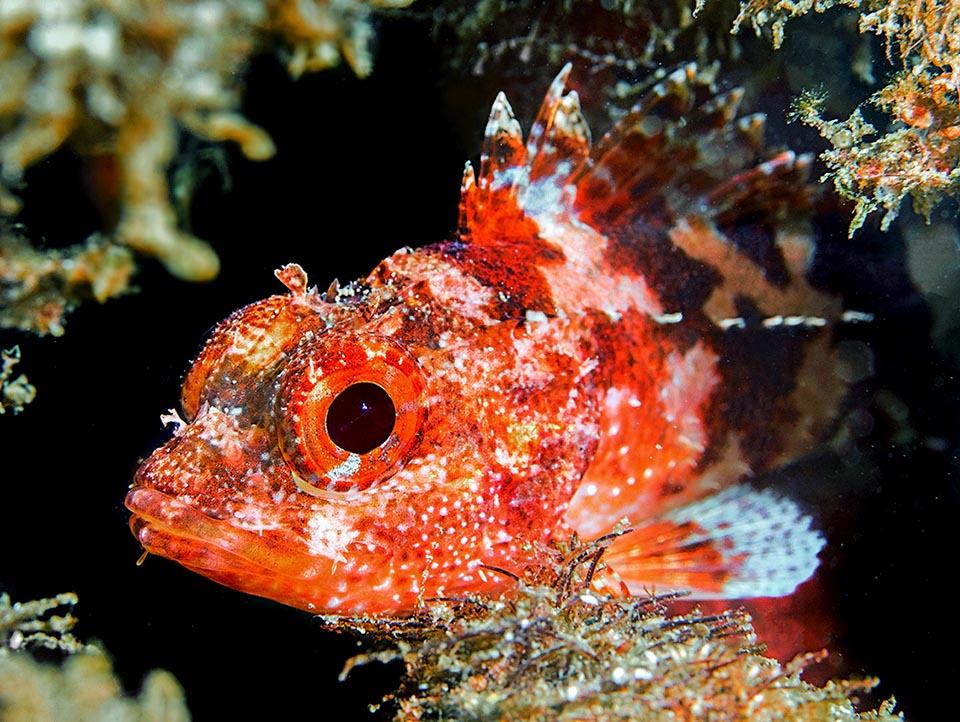
The eye is big for a perfect vision even in the dark and hunts in ambush small crustaceans and small fishes it sucks suddenly opening wide the mouth © Rafi Amar
There is only one dorsal fin with the 12 spiny poisonous rays, that it rises against the importunate, and 9-10 soft rays; the anal counts 3 spiny rays and 4-5 unarmed; the ventral one one spiny ray and 5 unarmed and the pectoral ones 15-16 soft rays. The caudal fin is rounded.
The eye is relatively big for a perfect vision of the prey even where the light is poor.
If compared to similar but rather bigger species, Scorpaena maderensis easily distinguishes for the more slender head and the absence of cutaneous flaps on the body from Scorpaena notata and Scorpaena porcus, which has more three characteristic dark bands on the caudal fin.
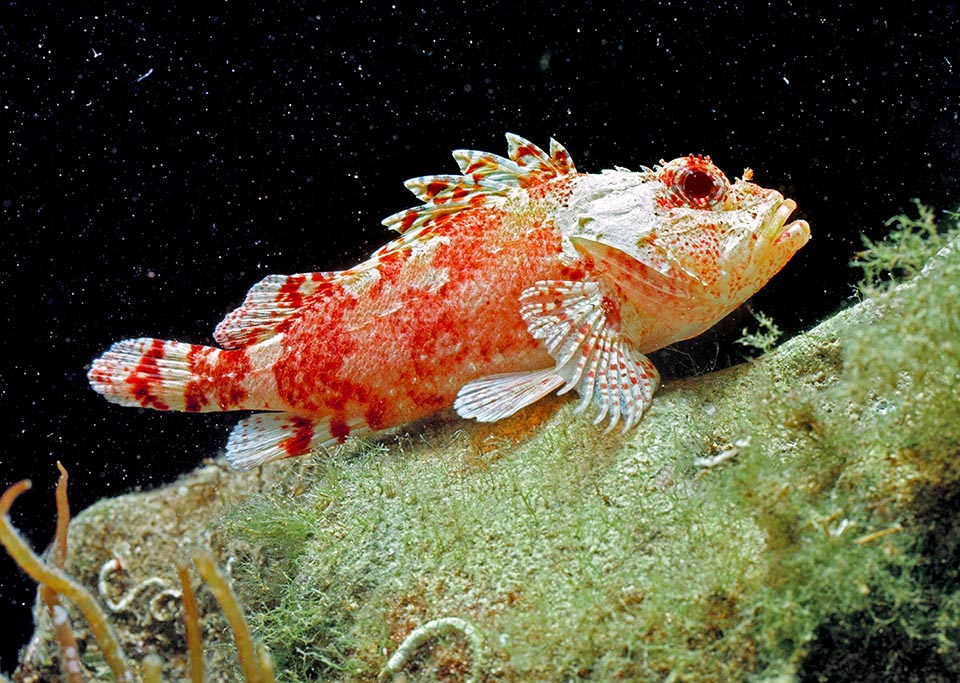
The females, bigger and more long-lived than males, release a gelatinous mass of eggs but various aspects of the reproduction and on the larvae growth are still unknown © Giuseppe Mazza
Ethology-Reproductive Biology
The Madeira rockfish feeds on small crustaceans and fishes it sucks, opening wide suddenly its mouth. The venom, used only for defense, may cause painful stings but has no serious consequences for humans. In case of an accident, the affected part is to be immediately submerged in warm water, because the heat around the 45 °C destroys its active principles.
For the reproduction the females, which reach the sexual maturity before the males, release a gelatinous mass of eggs, immediately fecundated by the partner.
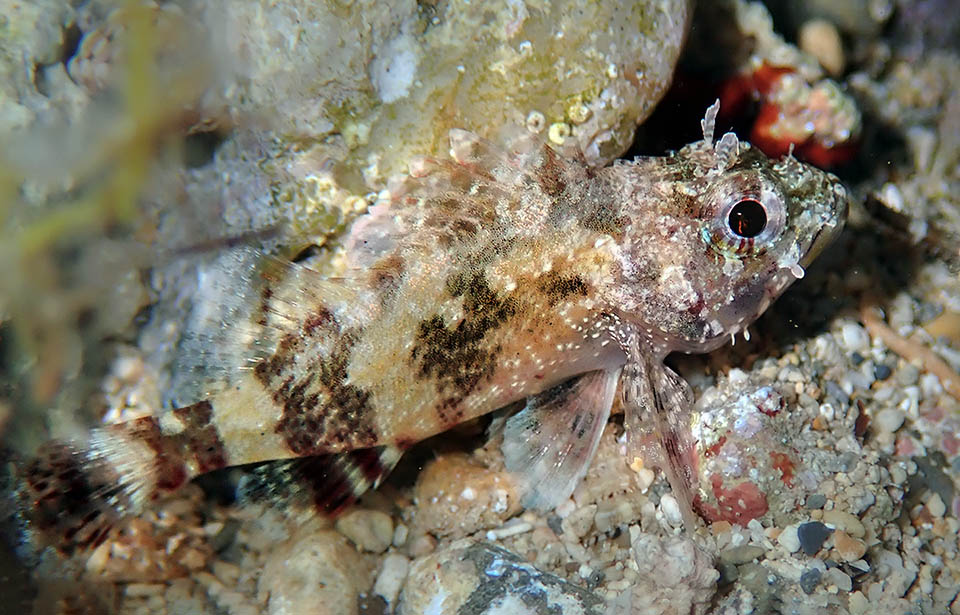
A young. We already note well the elements of the livery with the typical small white lines facing each other in the narrowest point of the caudal peduncle © Matthew Smith
They originate planktonic larvae and the lifespan is then of 4 years for the males and 5 for the females.
Resilience seems mediocre, with a possible doubling of the populations in 1,4-4,4 years, and the fishing vulnerability, moderate, marks 36 on a scale of 100. Scorpaena maderensis appears in the Red List of the endangered species as “Least Concern”.
Synonyms
Sebastes maderensis Valenciennes, 1833; Sebastipistes maderensis Valenciennes, 1833; Scorpaena rubellio Jordan & Gunn, 1898.
→ For general information about fishes please click here.
